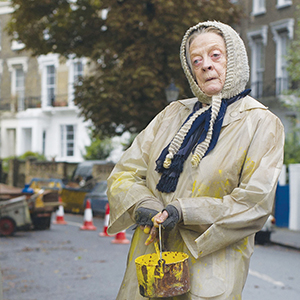

A charming memoir of a smelly, prickly old lady, The Lady in the Van is based on material that was first performed on stage, then as a radio play. Surprisingly, as a movie it hasn’t lost any keenness.
Its writer and subject is Alan Bennett (played by Alex Jennings), a playwright whose breakthrough was being part of the Beyond the Fringe quartet that paved the way for Monty Python. In 1973, when Bennett moved to Gloucester Crescent in London’s Camden Town, it was a changing district—awaiting the gentry who inhabit it today. Priding themselves on their liberality, the neighbors put up with one Miss Shepherd (Dame Maggie Smith) a transient old lady living in her van on the street. When the parking police tried to run her off, Bennett allowed her to park in his driveway. She would be encamped there for 15 years.
Bennett once commented that he thought he’d go into the clergy just because he looked like a clergyman. Jennings’ Bennett does look like a vicar: tall, self-effacing, awkward, limp-haired. In his never-to-be-forgot Beyond the Fringe sketch, “Take a Pew,” Bennett played a minister trying to explain, with multiple inanities and chummy, hopeless faux-contemporary allusions, the importance of a scripture verse from II Kings 14. The quote was actually from Genesis: “But my brother Esau is a hairy man, but I am a smooth man.”
The funny thing is that Bennett ended up a bit of a non-denominational minister, after all. As opposed to the more overt (and boring) St. Francis imagery in The Soloist—the Jamie Foxx-starring movie on a similar subject to this—The Lady in the Van is a sweet, subdued piece of natural Christianity.
During the course of his friendly but never informal relationship with Miss Shepherd, Bennett often has a good talk to himself. The play depicts Bennett split in half on the grounds that a writer is actually two people in conversation with himself. And while watching this strange woman, and learning her own sad history, he has some guilt about using her for material.
Nicholas Hytner is primarily a theater director and an occasional filmmaker. He has made three movies this century. Bennett’s direct address to the camera doesn’t look stagey, and the movie is opened up to take in the hilliest, most endearing part of London as it was 40 years ago. The role is so right for Smith that it might be easy to underrate her very tough and touching work here. (Think of the twinkling a less rigorous actor would have brought to this. Smith’s derelict Miss Shepherd is no pixie.)
Smith has long been a deep-focus underplayer, from her helpless Desdemona to Olivier’s Othello, to 1987’s Lonely Passion of Judith Hearne—the soul is so strong in her that we never really think of this 80-year-old performer’s fragility until the end of the film, when her health fails. Before then, her Miss Shepherd has push. She is willing to be a pain; snarling at anyone who dares to play music around her, or talking grandly of her memoirs, to be titled either The Lady Behind the Curtain or A Woman of Britain.
The fragrance of Miss Shepherd is described as that of “a bad dish cloth”; out of folk wisdom, she eats raw onions to ward off colds. Alan, not an enormous fan of the physical world, admires the way the ambulance people or the social workers can handle this exasperating woman without minding her moods or her smell. He himself downplays his own ability to stand her bad habits, including her regularly soiling his driveway. “Caring is shit,” Alan decides. Indeed, cleaning up shit, and putting up with it, is essential to dealing with human beings, instead of being a wry outsider who avoids them.
It’s bemusing to imagine the army of people in their vans, trucks and campers today, displaced by the obscene rents of the Bay Area, being looked after with the care and dignity demonstrated by the characters in this story. The Lady in the Van wells up with compassion; it never drills for it.
The Lady in the Van
PG-13; 104 Mins.
Camera 7, Campbell



